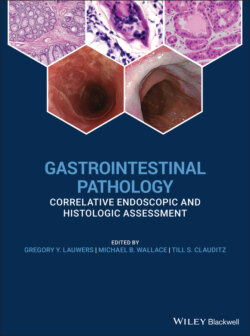Читать книгу Gastrointestinal Pathology - Группа авторов - Страница 35
Summary
ОглавлениеThe role of pathology in gastrointestinal endoscopy remains critical. Gastroenterologists should have a thorough knowledge of optimal methods of tissue removal and initial processing to allow optimal diagnosis and therapeutic results. Advances in endoscopic resection have allowed complete resection of many early cancers but require closer cooperation between the endoscopist and pathologist to ensure the tissue is properly handled and staged. With EUS‐FNA, the direct interaction of pathologist with rapid on‐site cytological evaluation has led to higher accuracy, and reduced the need for repeat procedures. Finally, advances in imaging will continue to improve the targeting of tissue sampling and reduce the need for low‐yield random sampling methods.
Figure 1.14 Endoscopic submucosal dissection (ESD) procedure. A flat neoplastic lesion is seen in panel 1–2 after staining with cresyl violet. The margins are incised (panel 3) with the endoscope retroflexed (black tube). The submucosal plane is dissected with a needle knife (panel 4). The final resection site (panel 5) and corresponding resection specimen prepared for pathology processing (panel 6).
Figure 1.15 Endoscopically resected en bloc well‐differentiated adenocarcinoma 28 × 17 mm with superficial submucosal invasion and no lymphovascular invasion and negative horizontal and vertical margins. This sample meets criteria for endoscopic curative resection.
Figure 1.16 Large mediastinal lymph node sampled with EUS‐FNA. The needle is seen entering from the upper right of the screen into the tumor in the center of the image.
